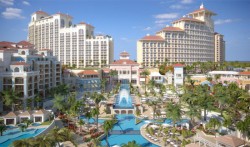Cat Cay Club President Lance Mortensen says, “We certainly are disappointed that theyメre even still considering LNG and we hope that they will take the opportunity before making any decisionナto put on a referendum for the people of The Bahamas to make a decision whether LNG is the correct thing to be putting in the country,” Mr. Mortensen told The Bahama Journal.
The opposition that residents on tiny Cat Cay have to LNG is nothing new.
In April 2005, the clubメs then president, Manuel Diaz, grabbed headlines when he and then Minister of Trade and Industry Leslie Miller got into a nasty spat at a meeting that was being held on the island to discuss the LNG plant AES wants to build on the uninhabited Ocean Cay, which sits 7.8 miles from Cat Cay.
During that meeting, Mr. Diaz vowed, “The Bahamian flag represents bright sunshine, crystal clear blue waters and a black nation. There are no LNG symbols on it and you can rest assured that it will be a very cold day in hell before that ever happens.”
Mr. Mortensen said Cat Cay residents remain concerned, and they donメt want to see The Bahamas become the dumping ground for the U.S.
“Obviously, the residents of Cat Cay [and the Bahamian staff members that we have] find it just incomprehensible that the government would even consider putting LNG in the country, let alone near an island where so many people reside,” he said in a recent interview with The Bahama Journal.
“Our fears are the same that weメve expressed from day one. We believe it would have a terrible impact on the environment. It would greatly affect everything from the lobster industry to the fisheries based on the change in water temperature that that plant [would cause]ナThe Bahamas, we feel, has never been based on that type of an industry, and tourism has always been a big push.”
But the need for diversification is precisely one of the reasons the government is backing LNG, according to Minister Miller, who has supported LNG projects since he became minister in 2002.
Mr. Mortensen, however, believes the government needs to take a second look at its LNG approval.
“The message to the government should be very simple, and thatメs that they should go out to the Bahamian population as a whole and ask the question whether LNG is really good for The Bahamas,” he said.
“We think that it sends the wrong message to the world that The Bahamas could be taken advantage of to have some company come in and convince them that itメs good for the people of The Bahamas.
“In our opinion, The Bahamas should not sell out and certainly if they ever made a deal for LNG, they certainly should with great respect re-analyze what really is the payment that theyメre receiving versus what the end result might be to the country as a whole.”
But officials of AES have continued to defend their plans.
“AES from the very beginning has been fully committed to making sure that the facility is going to both meet all environmental [requirements] as well as being a very safe operation,” said Robin Pence, AESメs vice president of communications, in an earlier interview with The Bahama Journal.
“We feel that we have met all conditions for both of those qualifications.”
Asked at the time why AES chose The Bahamas, Ms. Pence said, “I think what has made this such a good location is that it is an uninhabited island. Itメs far from any tourist or population centre as opposed to being on the mainland and next to any population centre. So this is a remote island far from anything and from that perspective it has been deemed the best site and it is also the safest and most environmentally-friendly.”
Ms. Pence said the project is estimated to make direct payments to the Government of The Bahamas of approximately $700 million over the first 25 years of operation. She said it would also create jobs over the two-year construction phase and then permanent jobs for people who would maintain the facility.
Asked recently whether the government has satisfied all of the concerns of local environmentalists, Minister Miller said he does not think the government would ever be able to satisfy the so-called concerns of people who are just opposed to industrialization.
“I call them arm-chair environmentalists,” he said, “not in a derogatory manner, but in the sense that the Government of The Bahamas went out and got the best available companies that do EIAs in the world. There are about five of them and three of those companies have worked on [the AES] project.”
Minister Miller said the companies have advised that it is feasible to have an LNG regasification terminal operating in The Bahamas in a safe and sustainable manner that would not adversely affect the environment. He stressed that this determination was “a scientific fact.”
He stressed again that LNG would diversify the economy and said it has also gotten the stamp of approval from the World Bank and the International Monetary Fund.
Initially, the AES LNG project is expected to create 650 jobs, according to Minister Miller, who said 400 of those jobs would be reserved for Bahamians, and the other 250 for foreign experts.
By: Candia Dames, The Bahama Journal



